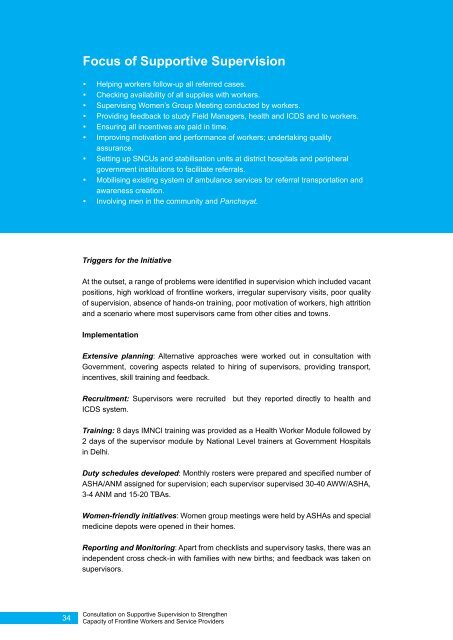Download the complete report - Unicef
Download the complete report - Unicef
Download the complete report - Unicef
Create successful ePaper yourself
Turn your PDF publications into a flip-book with our unique Google optimized e-Paper software.
Focus of Supportive Supervision<br />
• y Helping workers follow-up all referred cases.<br />
• y Checking availability of all supplies with workers.<br />
• y Supervising Women’s Group Meeting conducted by workers.<br />
• y Providing feedback to study Field Managers, health and ICDS and to workers.<br />
• y Ensuring all incentives are paid in time.<br />
• y Improving motivation and performance of workers; undertaking quality<br />
assurance.<br />
• y Setting up SNCUs and stabilisation units at district hospitals and peripheral<br />
government institutions to facilitate referrals.<br />
• y Mobilising existing system of ambulance services for referral transportation and<br />
awareness creation.<br />
• y Involving men in <strong>the</strong> community and Panchayat.<br />
Triggers for <strong>the</strong> Initiative<br />
At <strong>the</strong> outset, a range of problems were identified in supervision which included vacant<br />
positions, high workload of frontline workers, irregular supervisory visits, poor quality<br />
of supervision, absence of hands-on training, poor motivation of workers, high attrition<br />
and a scenario where most supervisors came from o<strong>the</strong>r cities and towns.<br />
Implementation<br />
Extensive planning: Alternative approaches were worked out in consultation with<br />
Government, covering aspects related to hiring of supervisors, providing transport,<br />
incentives, skill training and feedback.<br />
Recruitment: Supervisors were recruited but <strong>the</strong>y <strong>report</strong>ed directly to health and<br />
ICDS system.<br />
Training: 8 days IMNCI training was provided as a Health Worker Module followed by<br />
2 days of <strong>the</strong> supervisor module by National Level trainers at Government Hospitals<br />
in Delhi.<br />
Duty schedules developed: Monthly rosters were prepared and specified number of<br />
ASHA/ANM assigned for supervision; each supervisor supervised 30-40 AWW/ASHA,<br />
3-4 ANM and 15-20 TBAs.<br />
Women-friendly initiatives: Women group meetings were held by ASHAs and special<br />
medicine depots were opened in <strong>the</strong>ir homes.<br />
Reporting and Monitoring: Apart from checklists and supervisory tasks, <strong>the</strong>re was an<br />
independent cross check-in with families with new births; and feedback was taken on<br />
supervisors.<br />
34<br />
Consultation on Supportive Supervision to Streng<strong>the</strong>n<br />
Capacity of Frontline Workers and Service Providers

















